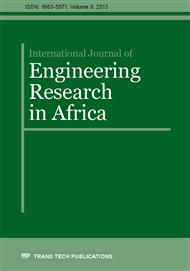[1]
Motorola Inc., Understanding and achieving next-generation wireless security, in B. Bing (Ed.), Emerging technologies in wireless LANs: theory, design and deployment, Cambridge University Press, UK, 2008, 131 - 143.
DOI: 10.1017/cbo9780511611421.009
Google Scholar
[2]
R. A. Kemmerer, An introduction to internet security, Lecture Note on Computer Security and Privacy, Computer Science Department, University of California, USA, 2012. www.cs.ucsb.edu/~kemm/courses/CS177/internetsec.pdf
Google Scholar
[3]
B. Schneier, We are all security consumers, IEEE Security & Privacy Magazine, 1:1 (2003) 104-104.
DOI: 10.1109/msecp.2003.1177006
Google Scholar
[4]
L. Wenjing and R. Kui, Security, privacy, and accountability in wireless access networks, IEEE Wireless Communications, 16:4 (2009) 80-87.
DOI: 10.1109/mwc.2009.5281259
Google Scholar
[5]
M. Caloyannides, Privacy vs. information technology, IEEE Security & Privacy Magazine, 1:1 (2003) 100-103.
DOI: 10.1109/msecp.2003.1177005
Google Scholar
[6]
H. Hassan and Y. Challal, Enhanced WEP: an efficient solution to WEP threats, In Second IFIP International Conference on Wireless and Optical Communications Networks, WOCN 2005, 594-599.
DOI: 10.1109/wocn.2005.1436095
Google Scholar
[7]
E. Tews, R. P. Weinmann, and A. Pyshkin, Breaking 104 Bit WEP in less than 60 seconds, Information Security Applications, (2007) 188-202.
DOI: 10.1007/978-3-540-77535-5_14
Google Scholar
[8]
G. Lackner, Security and Privacy Aspects of Wireless Computer Network, PhD Thesis, Graz University of Technology, Austria, 2011.
Google Scholar
[9]
N. Borisov, I. Goldberg, and D. Wagner, Intercepting mobile communications: the insecurity of 802.11, In Proceedings of the Seventh Annual International Conference on Mobile Computing and Networking, Rome, Italy, 180-189, July 2001.
DOI: 10.1145/381677.381695
Google Scholar
[10]
A. Klein, Attacks on the RC4 stream cipher, Designs, Codes and Cryptography, 48:3 (2008) 269.
DOI: 10.1007/s10623-008-9206-6
Google Scholar
[11]
IEEE, IEEE 802.11i-2004 Amendment to IEEE Std 802.11, 1999 Edition (Reaff 2003). IEEE Standard for Information technology Telecommunications and information exchange between system Local and metropolitan area networks Specific requirements Part 11: Wireless LAN. IEEE, 2004.
DOI: 10.1109/ieeestd.2014.6774846
Google Scholar
[12]
E. Sithirasenan, S. Zafar, and V. Muthukkumarasamy, Formal Verification of the IEEE 802.11i WLAN Security Protocol, In Australian Software Engineering Conference (ASWEC'06), pages 181-190.
DOI: 10.1109/aswec.2006.29
Google Scholar
[13]
R. S. Dhaka, A. Dhaka and P. S. Hada, AirPTWFrag: a new wireless attack, International Journal of Scientific & Engineering Research, 3:3 (2012) 1 – 4.
Google Scholar
[14]
V. Ramachandran, BackTrack 5 wireless penetration testing: Beginner's guide, Packt Publishing, Birmingham – Mumbai, 2011.
Google Scholar


